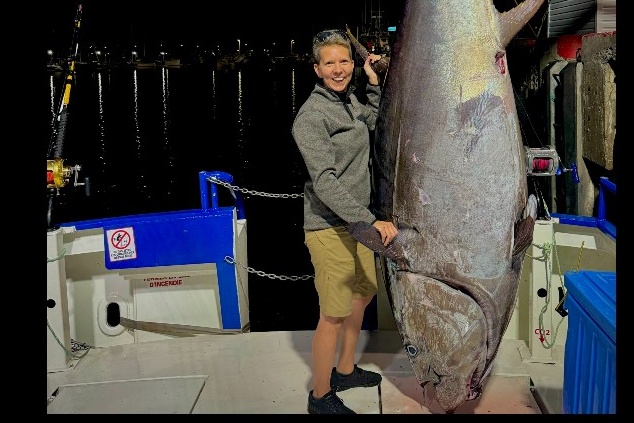(Montreal) A fishmonger from Rimouski, who caught an 850-pound (385-kilogram) bluefin tuna in the Gulf of St. Lawrence, will put her catch up for sale on Thursday.
Sarah Landry has nothing against the bluefin tuna that is usually found in Quebec restaurants and fishmongers.
But the one she caught a few days ago, “it’s the Bluefin, it’s another quality, it’s not the same thing, it’s such beautiful meat that we don’t want to freeze it for the winter.”
So she will put the fish pieces up for sale on Thursday morning and “if there are any left on Thursday night, there won’t be many left, it should be a very good day,” said the entrepreneur who caught a fish that weighs about seven times her own weight.
On average it’s 500 or 600 pounds, but at 850 pounds it’s starting to get big, it’s the biggest I’ve heard of.
Sarah Landry
Bluefin is the type of bluefin tuna most prized by chefs and quality tests carried out on the flesh of the 850-pound colossus reveal a Grade A.
“It’s exceptional quality, with the beautiful red and the perfect, perfect taste,” Sarah Landry told The Canadian Press.
Going out to sea to catch tuna, transporting it, having it cut up by professionals and carrying out quality tests, “it costs in the five figures”, explained the entrepreneur.
“We’re selling it to the consumer at $35.95 a pound,” she added, noting that her prey will have 475 pounds of meat left once the carcass is removed.
A long fight
The fishing story began overnight Thursday night in the waters of the Gulf of St. Lawrence near Miscou Island in New Brunswick, about five minutes after he cast a line baited with freshly caught mackerel into the water.
While the tuna quickly took the bait, getting it out of the water was “a long-term battle” that lasted nearly an hour and a half.
“You have to be able to listen to him a little. When he starts to pull too much, you have to give him some looseto bring him back better, and when he gets tired, that’s when you have to bring him back while making sure he doesn’t go under the boat, but you can’t give him too much slack because that’s when he can struggle and come unstuck, so you have to be careful,” summarized Sarah Landry, who was accompanied by her father, a friend and a professional fisherman during the expedition.
According to the Rimouski fishmonger, the demand for red tuna, “often eaten as tataki or tartare,” has been “very strong for several years” in her region.
Overfishing and quotas for an endangered species
Bluefin tuna’s status as a premium fish in sushi and sashimi preparation has made it particularly popular, especially in Japan. A large bluefin tuna can easily produce hundreds of meals.
But that popularity has put pressure on the stock.
Bluefin tuna is listed as endangered by the International Union for Conservation of Nature, due to years of overfishing.
International regulators, however, believe the species is not endangered enough to prohibit fishing.
In Quebec, around fifty fishermen have a permit to fish for bluefin tuna.
Fishmongers, like Sarah Landry, who want to buy this fish, can go out to sea with a permit holder to catch one.
In Canada, a fisherman can take one or two bluefin tuna out of the sea per year, depending on the quotas allocated by Fisheries and Oceans Canada.
The re-emergence of bluefin tuna in the Atlantic has sparked debate among fishermen, conservationists and scientists about how far this giant has recovered.
